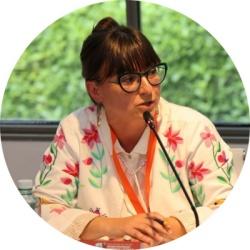
Science is not the only discipline that should inform public policy and, on the other hand, we must be aware of the limits of scientific information.
The committment of more than 50 global biodiversity expert voices has articulated the first edition of the 2025 ‘Diálogos Mutis de Biodiversidad’ held in early June, an event designed to promote debate and exchange between scientific voices, management specialists, representatives of public institutions and philanthropic and non-governmental institutions. The main theme of the session is as stimulating as it is ambitious: sharing actions to protect biodiversity, mobilising new financial and technological agreements to conserve ecosystems, and working in collaboration with local communities.
Science and public policy, financing and innovation for biodiversity structured the session. Image: CAF.
CREAF is actively participating with the intervention of Alicia Pérez-Porro, Head of Policy Interaction and Institutional Relations, as a speaker at this meeting convened by CAF-Bank of Latin America and the Caribbean and the Ministry of Ecological Transition and Demographic Challenge. "Bringing science closer to public policies requires people with a hybrid profile and, above all, professionalised, capable of speaking the language of science and that of political action, and who are dedicated to being agents of knowledge", said Pérez-Porro.
CREAF’s Head of Political Engagement also insisted that science is not the only discipline that should inform public policy: "we must be aware of the limits of scientific information. If we focus on biodiversity, for example, we must bear in mind its multi-level governance and the importance of sub-national governments". Referring to global warming, he recalled that cities act as climate refuges, which opens the door to local advice that also requires professionals with a hybrid approach.
Relevant, accessible and applicable
Some of the voices heard at the session included the biologist Mauricio Diazgranados - the first Latin American to direct the New York Botanical Garden - who called for science to be “relevant, accessible and applicable” and listed some ways to ensure its inclusion in public policies, such as monitoring, adaptive feedback, the creation of scientific advisory councils in local governments, the creation of biodiversity and climate change observatories with intersectoral participation, and networks that cooperate on a cross-border scale, among others.
Gunna Chaparro, leader of the Arhuaca Community in Colombia, explained the direct experience of the geographical area of the Sierra Nevada de Santa Marta, with subsistence-oriented agriculture. From a different register, the president of the Mexican Academy of Sciences, Dalila Aldana, called for "a science aimed at decision-making, at citizens, and at building solutions that are not only immediate, cheap and popular, but also have an effect on the vote".
The rector of the EAN University, the Colombian transgender biologist Brigitte Baptiste, mentioned the concept of transecology, which links ecology, dissidence and diversity. With a view that challenges the traditional limits of science, Brigitte Baptiste proposes new ways of conceiving the relationship between nature and culture and underlines the urgency of rethinking the frameworks of knowledge and action in the face of the climate crisis.
The 'Mutis Biodiversity Dialogues 2025' seek to share actions to protect biodiversity, mobilise new financial and technological agreements to conserve ecosystems and work collaboratively with local communities.
Promoting an innovative scientific culture and evolving to a collaborative model to co-design policies and identify solutions are other actions that have been shared. For example, CAF-Bank of Latin America and the Caribbean Manager, Alicia Montalvo, called for interdisciplinary work, social legitimacy, communication as an essential task against misinformation, supra-national action and integrated systems of accessible and credible information. “We must work for a public good such as biodiversity”, says Montalvo, “and financial instruments are needed for greater profitability, data, technology and artificial intelligence are needed to give biodiversity and nature their full potential”.
Among the 50 specialised voices are representatives from the West Indies University of Mona in Jamaica, the Massachusetts Institute of Technology, UNDP Latin America, the International Development Finance Club, The Nature Conservancy, the Patagonia Azul Foundation, the rector of the EAN University, the Spanish cooperation agency AECID, the governments of Brazil, Costa Rica, Mexico, Peru, Uruguay and Chile, as well as media representatives from all over Latin America and the Caribbean.
60% of global biodiversity
Latin America and the Caribbean include 60% of the world's biodiversity and 6 of the most biodiverse countries on the planet. It is also the geographical area where the COP30 on climate will be held in November 2025 in Brazil and which hosted the COP16 on biodiversity in October 2024 in Colombia. Following the integrative spirit of the Spanish-American botanist José Celestino Mutis, the Dialogues aim to strengthen cooperation between Latin America, the Caribbean and Spain through exchange and collaboration between science, policy and funding, to address today's ecological and climate challenges.
The Spanish Minister for Energy Transition and Demographic Challenge, Sara Aagesen, opened the 'Mutis Biodiversity Dialogues 2025'. Image: CAF.
“Fifty percent of the world's GDP depends directly on nature”, according to Sergio Díaz-Granados, President of CAF, the banking institution behind the Dialogues together with the Ministry of Ecological Transition and Demographic Challenge. For her part, Minister Sara Aagesen stressed that "2024 is the warmest year since records began. We are reaching 1.5°C, so we are no longer talking about a future risk, we are talking about the present".
The Royal Botanical Garden of Madrid hosted the meeting as an authentic living museum in the centre of the city that allows visitors to enter a green space with more than 5,500 plant species.

